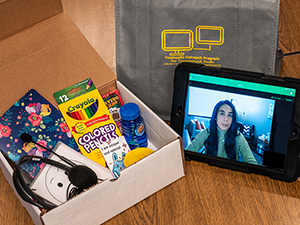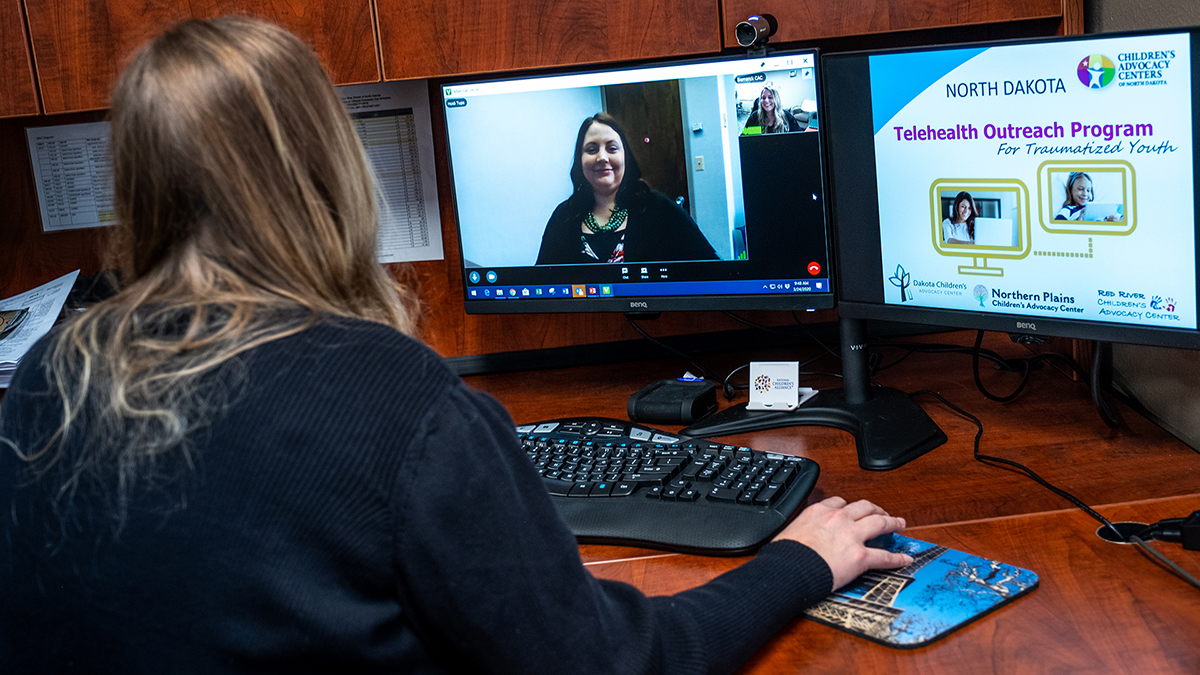Healing: Promising Mental Health + Medical Trends
Teleboxes for Telehealth
Above: Dakota CAC Executive Director Paula Condol, MS, LPCC, (seated) and Red River CAC’s Heidi Tupa, MSW, LICSW, (onscreen) demonstrate how the telehealth system works.
Long before the pandemic made telehealth part of the “new normal” for CACs, North Dakota was ahead of the curve. In last year’s Annual Report, we introduced you to Paula Condol, MS, LPCC, executive director of the Dakota Children’s Advocacy Center in Bismarck, and Dr. Nicola Herting, mental health director for the Red River Children’s Advocacy Center in Fargo, who used a grant from NCA to begin rolling out telehealth programs in April 2019.
They became an invaluable resource for other NCA members in 2020, when the pandemic pushed CACs to set up their own programs to deliver mental health treatments using telehealth technology. They not only participated in multiple webinars about telehealth, they also offered to talk directly to their peers across the country to share information.
One common problem with telehealth programs is “not all clients have the tools and resources to engage in telehealth—they might not have the equipment,” says Condol. So together, the North Dakota CACs had come up with the idea of “teleboxes”—a box that contains all the tools that a client needs to participate in telehealth, including an iPad that is restricted-use but data-enabled so it can be used wherever a cell signal is available, headphones, and the materials that will be used during the course of treatment. To ensure an equal starting point, every child participating in telehealth receives a box, irrespective of the family’s means or resources.

The contents of the teleboxes are modeled on the supplies used in Trauma-Focused Cognitive Behavioral Therapy (TF-CBT) but can be modified and adapted to other treatment modalities.
The boxes are age-appropriate and divided into age groups (7-9, 10-12, 13-18 years old), and the materials are placed in separate envelopes and labeled by session, such as “relaxation” so that the participants have something to look forward to opening as treatment progresses. The boxes contain items such as bubbles and stress balls for relaxation exercises; positive affirmation cards and journals for cognitive coping and for the trauma narrative; and packs of tissues for the difficult moments.
Thanks to North Dakota’s willingness to share its expertise, CACs looking to start up a telehealth program in the midst of a public health crisis could ramp up more quickly, turning to NCA’s webinars and COVID-19 resources to get tips from experts and little details, such as North Dakota’s contents list for their teleboxes.
